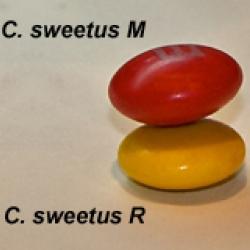Source Institutions
Source Institutions
Add to list Go to activity
Activity link broken? See if it's at the internet archive

This guided inquiry three-part activity engages learners in thinking about the mechanism of natural selection by encouraging them to formulate questions that can be answered through scientific investigation, data collection and pattern recognition. Learners are given a scenario in which a new species of clam is discovered. They will use M&Ms and Reese's Pieces and other simple materials to study variations within the clam population. Learners will collect and plot data to draw conclusions.
- 10 to 30 minutes
- 2 to 4 hours
- $10 - $20 per group of students
- Ages 11 - 18
- Activity, Experiment/Lab Activity, Lesson/Lesson Plan, Simulation
- English
Quick Guide
Materials List (per group of students)
- 12 sealable storage bags marked “C. sweetus strain M” (10 M&M candies minus the brown ones)
- 12 sealable storage bags marked “C. sweetus strain R” (10 Reese’s Pieces minus the brown ones)
- 12 paper cups or several paper towels marked “Waste”
- copies of the activity
- 12 small metric rulers
- one or more electronic balances (optional)
- 12 sealable food storage bags marked “C. sweetus strain M”. Each bag should contain 4 each of the yellow, blue, green, orange, and red candies. There should be NO brown candies in the mix.
- 12 waste containers (paper cups or paper towels)
- 12 sets of colored pencils/markers (red, blue, orange, green and yellow)
- a copy of the HHMI DVD Evolution: Constant Change and Common Threads, a DVD player or computer with a DVD drive and an LCD projector or monitor
Subjects
-
Earth and Space Science
- Earth's History
-
Life Sciences
-
Diversity of Life
- Animals
- Classification
-
Ecology
- Populations
-
Evolution
- Evidence for Evolution
- Mechanisms of Evolution
-
Heredity and Genetics
- Patterns of Heredity
-
Diversity of Life
-
Mathematics
-
Algebra
- Patterns
-
Data Analysis and Probability
- Data Analysis
- Data Collection
- Data Representation
- Probability
-
Measurement
- Rate
- Number and Operations
- Reasoning and Proof
- Representation
-
Algebra
-
The Nature of Technology
-
The Design Process
- Problem Solving
-
The Design Process
-
The Nature of Science
-
The Scientific Process
- Asking Questions
- Conducting Investigations
- Gathering Data
- Formulating Explanations
- Communicating Results
-
The Scientific Process
Informal Categories
- Animals
- Food and Cooking
- Nature and Environment
Audience
To use this activity, learners need to:
- see
- see color
- read
- touch
Learning styles supported:
- Involves teamwork and communication skills
- Involves hands-on or lab activities
Other
Components that are part of this resource:
Includes alignment to state and/or national standards:
This resource is part of:
Access Rights:
- Free access
By:
- Colvard, Mary
Rights:
- All rights reserved, Howard Hughes Medical Institute, 2010
